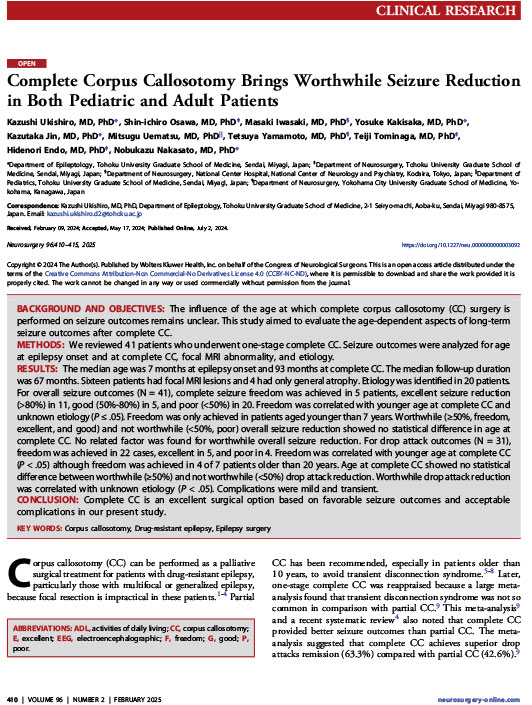Complete Corpus Callosotomy Brings Worthwhile Seizure Reduction in Both Pediatric and Adult Patients
February 2025 | Neurosurgery
Abstract
Background and Objectives
The influence of the age at which complete corpus callosotomy (CC) surgery is performed on seizure outcomes remains unclear. This study aimed to evaluate the age-dependent aspects of long-term seizure outcomes after complete CC.
Methods
We reviewed 41 patients who underwent one-stage complete CC. Seizure outcomes were analyzed for age at epilepsy onset and at complete CC, focal MRI abnormality, and etiology.
Results
The median age was 7 months at epilepsy onset and 93 months at complete CC. The median follow-up duration was 67 months. Sixteen patients had focal MRI lesions and 4 had only general atrophy. Etiology was identified in 20 patients. For overall seizure outcomes (N = 41), complete seizure freedom was achieved in 5 patients, excellent seizure reduction (>80%) in 11, good (50%-80%) in 5, and poor (<50%) in 20. Freedom was correlated with younger age at complete CC and unknown etiology (P ≤ .05). Freedom was only achieved in patients aged younger than 7 years. Worthwhile (≥50%, freedom, excellent, and good) and not worthwhile (<50%, poor) overall seizure reduction showed no statistical difference in age at complete CC. No related factor was found for worthwhile overall seizure reduction. For drop attack outcomes (N = 31), freedom was achieved in 22 cases, excellent in 5, and poor in 4. Freedom was correlated with younger age at complete CC (P < .05) although freedom was achieved in 4 of 7 patients older than 20 years. Age at complete CC showed no statistical difference between worthwhile (≥50%) and not worthwhile (<50%) drop attack reduction. Worthwhile drop attack reduction was correlated with unknown etiology (P < .05). Complications were mild and transient.
Conclusion
Complete CC is an excellent surgical option based on favorable seizure outcomes and acceptable complications in our present study.

